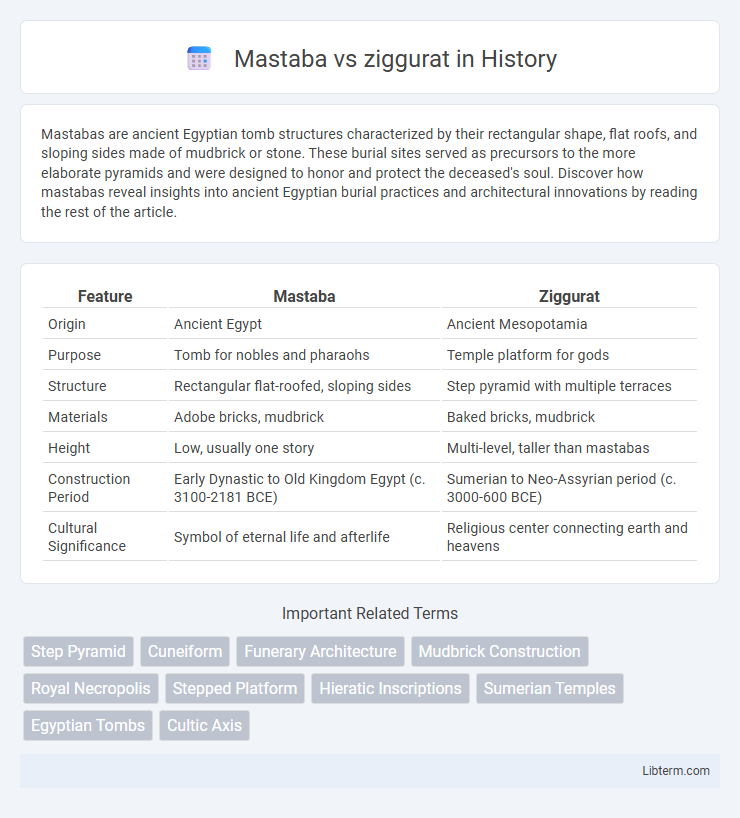Mastabas are ancient Egyptian tomb structures characterized by their rectangular shape, flat roofs, and sloping sides made of mudbrick or stone. These burial sites served as precursors to the more elaborate pyramids and were designed to honor and protect the deceased's soul. Discover how mastabas reveal insights into ancient Egyptian burial practices and architectural innovations by reading the rest of the article.
Table of Comparison
| Feature | Mastaba | Ziggurat |
|---|---|---|
| Origin | Ancient Egypt | Ancient Mesopotamia |
| Purpose | Tomb for nobles and pharaohs | Temple platform for gods |
| Structure | Rectangular flat-roofed, sloping sides | Step pyramid with multiple terraces |
| Materials | Adobe bricks, mudbrick | Baked bricks, mudbrick |
| Height | Low, usually one story | Multi-level, taller than mastabas |
| Construction Period | Early Dynastic to Old Kingdom Egypt (c. 3100-2181 BCE) | Sumerian to Neo-Assyrian period (c. 3000-600 BCE) |
| Cultural Significance | Symbol of eternal life and afterlife | Religious center connecting earth and heavens |
Introduction to Mastabas and Ziggurats
Mastabas are ancient Egyptian tomb structures characterized by their rectangular shape, flat roofs, and sloping sides, serving as burial sites for nobles and officials during the Early Dynastic and Old Kingdom periods. Ziggurats, prominent in Mesopotamian architecture, are massive terraced temples with successively receding levels, constructed to honor deities and serve as central religious sites. Both structures symbolize early monumental architecture but differ in purpose, design, and cultural significance within their respective civilizations.
Origins and Historical Context
Mastabas originated in ancient Egypt around 3100 BCE as early tomb structures featuring flat roofs and sloping sides, serving as precursors to pyramids in Old Kingdom burial practices. Ziggurats emerged in Mesopotamia around 3000 BCE, functioning as terraced step pyramids with religious significance, dedicated to local deities in Sumerian and Akkadian city-states. Both architectural forms reflect early urban civilization's focus on religious and funerary functions but differ in design and cultural context, with mastabas primarily serving as burial monuments and ziggurats as temple platforms.
Architectural Design and Structure
Mastabas feature a rectangular, flat-roofed structure with sloping sides built primarily from mudbrick or stone, serving as tombs in ancient Egypt. Ziggurats are massive stepped platforms with tiered, receding levels made of mudbrick, designed as religious temples in Mesopotamia. The mastaba's solid, enclosed form contrasts with the ziggurat's tiered, monumental height, emphasizing respectively funerary versus ceremonial functions.
Purpose and Cultural Significance
Mastabas served as ancient Egyptian tombs designed to honor and protect the deceased, reflecting the culture's emphasis on the afterlife and eternal preservation. Ziggurats were monumental stepped temples in Mesopotamia, dedicated to local deities and functioning as religious centers that symbolized the connection between heaven and earth. Both structures highlight the centrality of spirituality in their respective cultures, with mastabas emphasizing funerary practices and ziggurats focusing on communal worship and divine presence.
Building Materials and Techniques
Mastabas, ancient Egyptian tombs, were primarily constructed using mudbrick and limestone blocks, employing a flat-roofed rectangular design with sloping sides that enhanced structural stability. Ziggurats, Mesopotamian religious edifices, utilized sun-dried mudbricks with fired bricks on outer layers for weather resistance, featuring a tiered, stepped structure built on a solid core with internal support systems. Both structures reflect regional material availability and architectural innovations suited to their respective climates and cultural functions.
Religious and Ritual Functions
Mastabas served as ancient Egyptian tombs designed for the deceased's journey to the afterlife, featuring chapels and burial chambers to support religious rituals and offerings. Ziggurats functioned as Mesopotamian temple towers, acting as sacred platforms connecting heaven and earth, where priests conducted rituals to honor gods and maintain divine favor. Both structures symbolized spiritual connection but differed in purpose: mastabas emphasized funerary rites, while ziggurats facilitated ongoing worship and divine communication.
Comparative Analysis: Shape and Layout
Mastabas are rectangular, flat-roofed structures with sloping sides commonly used as ancient Egyptian tombs, featuring a simple, solid shape with an underground burial chamber. Ziggurats, in contrast, are massive terraced step pyramids built by Mesopotamians, characterized by their multi-level, receding platforms arranged in a tiered layout, often with a temple at the summit. The mastaba's compact and horizontal form contrasts sharply with the ziggurat's vertical, monumental design intended to elevate religious rituals closer to the heavens.
Geographic Distribution and Examples
Mastabas, primarily found in ancient Egypt, served as flat-roofed, rectangular tomb structures with outward-sloping sides concentrated along the Nile Valley, such as those at Saqqara and Meidum. Ziggurats, characteristic of Mesopotamian civilizations like Sumer and Babylon, are stepped pyramid temples located in modern-day Iraq and Iran, with prominent examples including the Great Ziggurat of Ur and the Etemenanki in Babylon. These architectural forms reflect distinct cultural and religious practices tied to their respective geographic regions in the ancient Near East.
Influence on Later Architecture
Mastabas influenced later Egyptian tomb designs by establishing the use of flat-roofed, rectangular structures with sloping sides, which evolved into the Step Pyramid, the precursor to true pyramids. Ziggurats shaped Mesopotamian architecture by inspiring monumental stepped platforms that served as temples, influencing the design of later religious structures across the Near East. Both structures contributed foundational concepts of vertical elevation and symbolic sacred space that resonated through successive architectural traditions.
Legacy and Modern Interpretations
Mastabas, ancient Egyptian tomb structures, influenced modern funerary architecture by emphasizing durability and symbolic representation of the afterlife, while ziggurats, Mesopotamian step pyramids, inspired religious and civic monumental designs highlighting tiered elevation to connect earth and heaven. The legacy of mastabas persists in the study of Egyptian burial customs and the evolution of pyramid construction, whereas ziggurats inform contemporary interpretations of sacred space and ancient urban planning in Mesopotamian culture. Modern scholarship uses both structures to explore early architectural techniques and sociopolitical symbolism in ancient civilizations.
Mastaba Infographic

 libterm.com
libterm.com